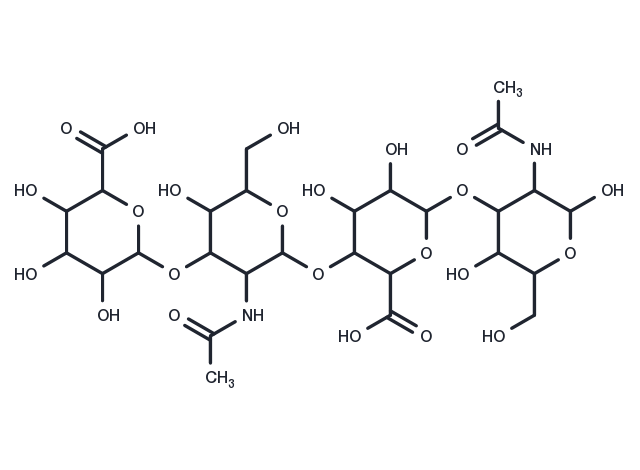Powder: -20°C for 3 years | In solvent: -80°C for 1 year


Hyaluronic acid (hyaluronan) is a glucosaminoglycan consisting of D-glucuronic acid and N-acetyl-D-glucosamine disaccharide units that is a component of connective tissue, skin, vitreous humour, umbilical cord, synovial fluid and the capsule of certain microorganisms contributing to adhesion, elasticity, and viscosity of extracellular substances.

| Pack Size | Availability | Price/USD | Quantity |
|---|---|---|---|
| 50 mg | In stock | $ 46.00 | |
| 100 mg | In stock | $ 64.00 | |
| 200 mg | In stock | $ 84.00 | |
| 500 mg | In stock | $ 139.00 | |
| 1 g | In stock | $ 175.00 |




| Description | Hyaluronic acid (hyaluronan) is a glucosaminoglycan consisting of D-glucuronic acid and N-acetyl-D-glucosamine disaccharide units that is a component of connective tissue, skin, vitreous humour, umbilical cord, synovial fluid and the capsule of certain microorganisms contributing to adhesion, elasticity, and viscosity of extracellular substances. |
| In vitro | Hyaluronic acid (HA) is extensively utilized across various medical fields due to its capacity to bind with numerous water molecules, thereby enhancing tissue hydration and mechanical resistance. Its significant roles include facilitating wound healing, ovulation, fertilization, signal transduction, and impacting tumor physiology, making it valuable in aesthetic medicine, joint disorder treatments like osteoarthritis and rheumatoid arthritis, and ophthalmology for its lubricative benefits on the corneal endothelium. High molecular mass HA impairs the chemotaxis and migration of inflammatory cells, thus serving as an effective barrier to inflammation and shielding from free radicals. Furthermore, HA contributes to aesthetic dermatology by minimizing mechanical damage to tissues with minimal side effects. Research also suggests its potential in identifying tumor markers, managing liver diseases, and application in pharmaceutical formulations. In cancer research, particularly digestive cancers, HA interactions with tumor cells may activate signaling pathways that promote proliferation, cell adhesion, migration, invasion, and contribute to angiogenesis, lymphangiogenesis, epithelial-mesenchymal transition, stem cell-like characteristics, and resistance to chemotherapy and radiation. |
| In vivo | HA (hyaluronic acid) is ubiquitous across biological fluids and tissues, with its beneficial effects on joint health evidenced by numerous animal studies. These studies have demonstrated that HA enhances cartilage matrix synthesis, prevents its degradation, mitigates inflammation, fosters the production of endogenous HA, and augments cartilage resilience and hydration. Additionally, topically applied high molecular weight HA formulations have been shown to expedite the healing of acute skin wounds and facilitate the recovery of venous leg ulcers, thereby offering a valuable option for chronic wound management. |
| Synonyms | Hyaluronate, hyaluronan |
| Molecular Weight | 800000~1500000 |
| Formula | (C14H21NO11)n |
| CAS No. | 9004-61-9 |
Powder: -20°C for 3 years | In solvent: -80°C for 1 year
H2O: 14.29 mg/mL, Sonication is recommended.
You can also refer to dose conversion for different animals. More
bottom
Please see Inhibitor Handling Instructions for more frequently ask questions. Topics include: how to prepare stock solutions, how to store products, and cautions on cell-based assays & animal experiments, etc.
Hyaluronic acid 9004-61-9 Metabolism Others Endogenous Metabolite Inhibitor inhibit Hyaluronate hyaluronan inhibitor
